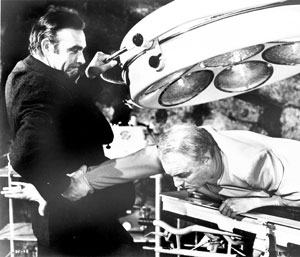

IF THE 007 films seem especially emblematic of the 1960s, maybe it’s because they were the first to take advantage of the icons of the day. Goldfinger was the first non-Beatles film to mention the Fab Four, the first movie to show a Ford Mustang and reportedly the first movie with a laser beam in it.
Two prime examples of 1960s Bond can be seen on a double bill this weekend at San Jose’s Retro Dome (once the beloved Century 25)—the perfect venue for 007 movies. First, the moment of detonation for Bond mania: the superb Goldfinger (1964); second, Sean Connery’s final canonical appearance as James Bond in Diamonds Are Forever (1971)—a basically paunchy film, though adorned with a dazzling satellite.
“Never use the same set twice,” was the rule for the original Bond features; the plots, however, could be repeated. In both movies, Bond sets out on the trail of smugglers when he divines a much more menacing conspiracy. One version of the script of Diamonds Are Forever even introduced the villain as Goldfinger’s identical twin brother, a diamond fancier to be played, again, by Gert Frobe.
Another Bond rule was outlined by scriptwriter Richard Maibaum’s motto “You have to pull down the balloon,” meaning that no matter how fantastical these adventures got, they needed to be matters of life and death.
Bond’s tough bit of bravado “Do you expect me to talk?” is rejoined by Auric Goldfinger’s “No, Mr. Bond, I expect you to die.” It’s a joke, but it isn’t. No matter how chummy the hero and villain became, there was a serious game afoot with plenty of collateral damage.
In addition to Connery, what really makes the Bonds survive is the populist idea behind them all: a civil servant going after a malefactor of great wealth and greed.
The censors wouldn’t pass the Ian Fleming detail that says it all: in the novel, Goldfinger is a genuine gold fetishist (an auriphile?) who hired women whom he painted gold. Not every man can invent a new fetish.
And then there was Connery: a former Mr. Universe who revealed as much skin as possible, such as the terrycloth onesie in Goldfinger. The wardrobe is deliriously parodied in the upcoming OSS 117: Lost in Rio. Clothes didn’t unmake this man; he was the cruel, taciturn agent, uneasy in dealing with superiors. Deadpan with bad puns, he woke up with a wolfish appetite for one or another high-haired girl. Connery’s unmatched magnetism keeps these films breathing.
The gruff Scotsman didn’t like just anyone, but these two movies are also linked in the rapport he enjoyed with his co-stars. In Goldfinger, the mature and fierce Honor Blackman as the gorgeously named pilot Pussy Galore; in Diamonds, auxiliary Rat Packer Jill St. John as Tiffany Case, a gaga redhead.
Seeing Diamonds Are Forever the very day it opened taught me my first lesson that the movies will take something you love and eventually turn it into something slightly embarrassing. Bond, revenging the death of his wife in the not-to-be-forgotten OHMSS (1969) justifies tossing a Persian cat at supercilious supergenius Ernst Stavro Blofeld (the ever-plummy Charles Gray). The less said about gaylord villains Bruce (father of Crispin) Glover and Putter Smith, as Mr. Wint and Mr. Kidd, the better.
And yet the old Las Vegas never looked better than is does here. As in Goldfinger, John Barry and Shirley Bassey pump the film with musical excitement, and there’s a fine brutal car chase in Glitter Gulch. Time has staled Diamonds a little, but there’s some zeitgeist in the finale, which takes place on an oil platform. Pity the villains aren’t BP executives.
Goldfinger
May 14-15, 7pm; May 16, 1pm
Diamonds Are Forever
May 14–15, 9:15pm; May 16, 3:15pm
Retro Dome, 1694 Saratoga Ave., San Jose
408.404.7711



